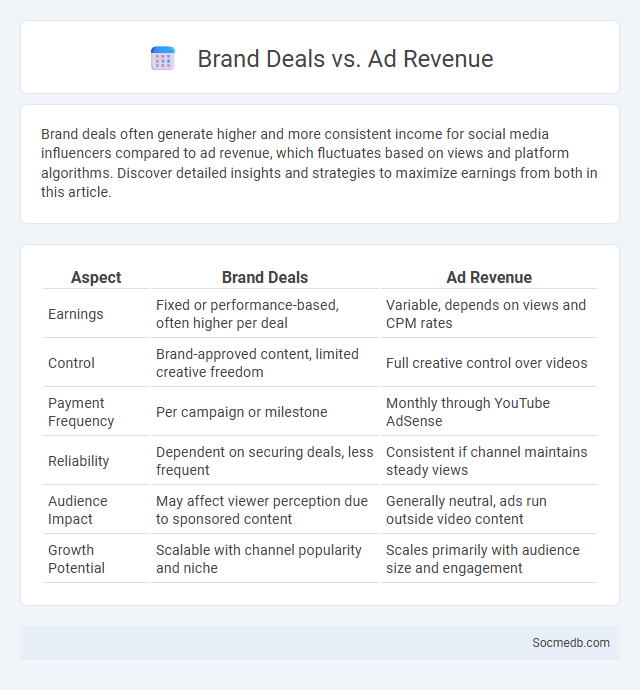
Photo illustration: Brand Deals vs Ad Revenue
Brand deals often generate higher and more consistent income for social media influencers compared to ad revenue, which fluctuates based on views and platform algorithms. Discover detailed insights and strategies to maximize earnings from both in this article.
Table of Comparison
| Aspect | Brand Deals | Ad Revenue |
|---|---|---|
| Earnings | Fixed or performance-based, often higher per deal | Variable, depends on views and CPM rates |
| Control | Brand-approved content, limited creative freedom | Full creative control over videos |
| Payment Frequency | Per campaign or milestone | Monthly through YouTube AdSense |
| Reliability | Dependent on securing deals, less frequent | Consistent if channel maintains steady views |
| Audience Impact | May affect viewer perception due to sponsored content | Generally neutral, ads run outside video content |
| Growth Potential | Scalable with channel popularity and niche | Scales primarily with audience size and engagement |
Understanding Brand Deals: An Overview
Understanding brand deals is essential for maximizing your social media influence and monetizing your content effectively. Brand collaborations typically involve sponsored posts, product placements, or affiliate marketing, where your audience engagement and follower demographics are key factors. Your ability to negotiate terms and maintain authenticity can significantly impact the success and longevity of these partnerships.
What is Ad Revenue in Digital Content?
Ad revenue in digital content refers to the income generated by displaying advertisements within social media platforms, websites, or videos. These earnings come from various formats such as display ads, sponsored posts, video ads, and affiliate marketing, which are targeted based on user behavior and demographics. Understanding how ad revenue works helps you optimize content strategies to maximize monetization opportunities effectively.
Brand Deals vs Ad Revenue: Key Differences
Brand deals typically involve direct partnerships between influencers or content creators and companies, providing tailored promotions that leverage the creator's unique audience and style. Ad revenue, on the other hand, is generated through platform-based monetization models like YouTube ads or Facebook Audience Network, relying on impressions and clicks rather than bespoke brand messaging. Understanding the distinction is crucial for creators aiming to maximize income, as brand deals often offer higher payouts and creative control, while ad revenue provides consistent, passive earnings.
How Brand Deals Impact Content Creators’ Earnings
Brand deals significantly boost content creators' earnings by providing lucrative sponsorship opportunities that often exceed ad revenue from platforms alone. These partnerships enable creators to monetize their audience through tailored promotions, increasing income stability and potential growth. Data shows creators with brand collaborations can earn up to 60% more compared to those relying solely on organic platform monetization.
Pros and Cons of Monetizing Through Ad Revenue
Monetizing through ad revenue on social media offers significant income potential by leveraging a large audience and targeted advertising, allowing you to capitalize on content popularity and platform algorithms. However, it can lead to fluctuating earnings due to changes in ad rates, algorithm updates, and potential audience disengagement caused by excessive ads. Balancing content quality and ad placements is crucial to maintain viewer trust and sustain long-term revenue growth.
Negotiating Brand Deals: Best Practices
Negotiating brand deals requires clear communication of your audience demographics, engagement rates, and unique value propositions to maximize your earning potential. You should establish transparent terms including deliverables, timelines, and payment schedules to protect your brand integrity and foster long-term partnerships. Leveraging data analytics and benchmarking industry standards enhances your confidence and ensures favorable contract outcomes.
Maximizing Income: Combining Brand Deals and Ad Revenue
Maximizing income from social media involves strategically combining brand deals with ad revenue to diversify your earnings. You can increase your financial gain by leveraging high-engagement content that attracts both advertisers and brands willing to pay premium rates. Optimizing your profile and consistently delivering valuable content enhances your appeal to sponsors and boosts your ad revenue streams.
Brand Suitability and Audience Trust
Social media platforms emphasize brand suitability by implementing advanced content filtering and brand safety technologies to ensure advertisements align with appropriate and contextually relevant environments. Maintaining audience trust relies on transparent data privacy policies, consistent content moderation, and the promotion of authentic interactions that foster positive user experiences. These strategies collectively enhance brand reputation and secure consumer confidence in digital marketing campaigns.
Future Trends in Brand Deals and Ad Revenue
Future trends in social media brand deals and ad revenue emphasize AI-driven personalization and immersive experiences like augmented reality to boost engagement. Brands increasingly prioritize authentic influencer partnerships and micro-influencers, driving higher ROI and trusted connections with niche audiences. Your strategy should evolve by leveraging data analytics to optimize ad targeting and capitalize on emerging platform monetization features.
Which Monetization Strategy Works Best for You?
Choosing the best monetization strategy for your social media depends on your content type, audience size, and engagement level. Sponsored posts, affiliate marketing, and selling digital products each offer unique advantages tailored to different platforms like Instagram, YouTube, or TikTok. Understanding your followers' preferences and analyzing performance metrics will help you maximize your social media revenue effectively.
 socmedb.com
socmedb.com